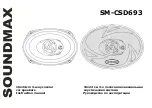
Room Acoustics
The single most affecting component of the sound is the room your system is placed
in. One could very well argue that the room
is
a part of the system. We believe so.
Some say 50% of the sound quality lies in room properties.
The next issue is that different speaker technologies (horn, bi-polar, di-polar, omni-
polar, line array, etc.) require somewhat different room properties. But there are more
similarities than differences. From the real world, you may recognise the different
sound of your own voice in a tiled bathroom compared to a cosy filled-with-fabric
master bedroom. Same voice, different sound. All due to room acoustic.
engelholm audio constructs and designs room acoustics – a very important area to
master if one are to build high performance speakers.
Sound reproduction in domestic rooms is a fascinating topic just by the fact that
wavelengths span from 30 meters (/115 ft) to 0,017 meter (0,06 ft) in the audible
range. Not surprisingly, the waves behave differently depending on wave length but
also room size. Long waves, bass tones, are handled by wave acoustic while the
higher frequencies are referred to as geometrical acoustic. Being different by nature,
the two acoustical types require different treatment technologies. Acoustical properties
have been known to man for a long time and the word it self origins from Greek:
κουστικός
ἀ
(
akoustikos
), meaning "of or for hearing, ready to hear" and that from
κουστός
ἀ
(
akoustos
), "heard, audible".
But here is a legacy problem. Way back then, the rooms did not look like today’s
domestic rooms. In the old days, acoustic was all about reverberation (RT60) and
how
fast
sound dies.
More recent studies show that human hearing decodes reproduced
sound better if the sound dies in a good way as opposed to just dies fast. It is more
interesting
how
the sound dies. We now know that sound must not die too fast and
that the so called energy time decay should have certain ideal properties to gain
maximum fidelity.
Three quick steps to better room acoustic
There are a few things you can do with, or more precisely in, your room that is
beneficial for your sound.
•
Make sure you have furniture in your room. The opposite, a room with no carpet, no
shelves, no paintings, no table, no sofa, no nothing is first of all not a nice place to
be in, but more important (from this manual's perspective) is that it will have a poor
sound.
Make sure your room is none compliant with today, 2011, interior design trends.
Make sure your room have an interior.
•
Find
1
the first reflection points from your solo; where is it on the side walls, back wall
and wall behind listening position? Make sure these reflection points are not a flat,
hard wall. Place books here, a painting, some shelves or maybe some curtains. Be
extra mindful if the points are windows. Think hard if you can position solo in
another way.
•
Is your room quiet or noisy? Do what ever you can to create a listening environment
that is quiet! For example there are doors with better damping properties, shutting
out outside noise. If you are in the position to build your room you can use double
layers of gypsum board (or such) to make the walls more efficient dampers. Make
1 Use a mirror to locate reflection points. Let another person hold the morror flat against and move it around the
wall. When you can see solo reflected in the mirror from listening position the mirror is placed at a reflection point.
by engelholm audio
Revision A
www.engelholmaudio.com
Page 5(11)































